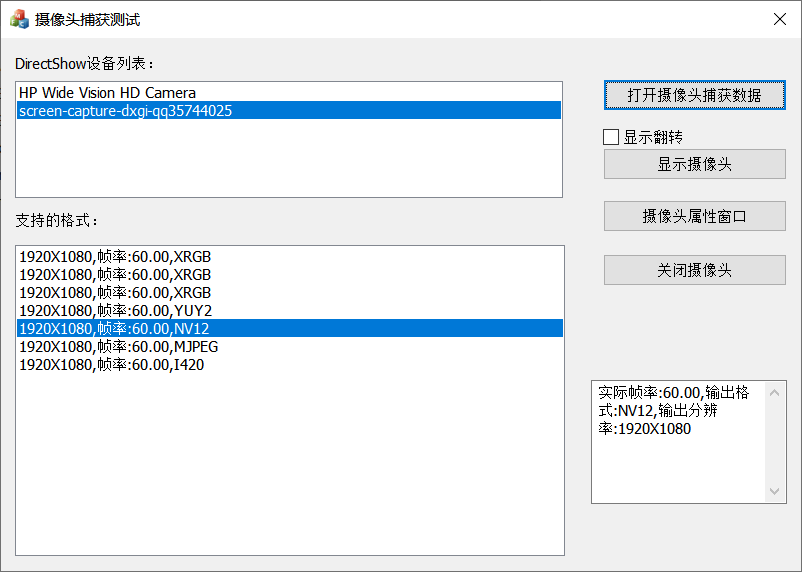

- #FFMPEG DIRECTSHOW INSTALL HOW TO#
- #FFMPEG DIRECTSHOW INSTALL INSTALL#
- #FFMPEG DIRECTSHOW INSTALL CODE#
- #FFMPEG DIRECTSHOW INSTALL DOWNLOAD#
We are close, but we still need to do some additional processing. Now, you may think you can use frames and show pixels on the screen or send samples to the sound card. Frames will contain timing informattion and the raw, uncompressed data. A packet may contain many frames but also a frame may require several packets for the decoder to build it. Please note that producing 1 frame does not always take exactly 1 packet. Packets are sent to a Codec and in turn, the codec produces Frames. All packets are of a specific MediaType (Audio, Video, Subtitle, Data), and contain some timing information and most importantly compressed data. A packet is a group of bytes read from the input. About how it worksįirst off, let's review a few concepts. If you'd like audio to not change pitch while changing the SpeedRatio property, you'll need the SoundTouch.dll library v2.1.1 available on the same directory as the FFmpeg binaries. See example URLs below and issue #48ĭevice://dshow/?audio=Microphone (Vengeance 2100):video=MS Webcam 4000 Perform custom stream reading and stream recording.įFME also supports opening capture devices.Change raw video, audio and subtitle data upon rendering.Capture stream packets, audio, video and subtitle frames.Opt-in hardware decoding acceleration via devices or via codecs.Ability to pick media streams contained in a file or a URL.The standard WPF MediaElement is severely lacking in this area. MediaState actually works on this control.Apply volume, balance and speed ratio to media playback.Extract media metadata and specs of a media stream (title, album, bit rate, codecs, FPS, etc).Easily apply FFmpeg video and audio filtergraphs.Extracting (and modifying) video, audio and subtitle frames is very easy. Properties such as Position, Balance, SpeedRatio, IsMuted, and Volume are all Dependency Properties.Fast media seeking and frame-by-frame seeking.This means that for those of you who want to support stuff like HLS playback, or just don't want to go through the hassle of installing codecs on client machines, using FFME might just be the answer.įFME provides multiple improvements over the standard MediaElement such as: While the standard MediaElement uses DirectX (DirectShow) for media playback, FFME uses FFmpeg to read and decode audio and video. The generated API documentation is available hereįFME is an advanced and close drop-in replacement for Microsoft's WPF MediaElement Control.Remember: The provides usage examples for plenty of features.Note: To build your own FFmpeg binaries, I recommend the Media Autobuild Suite but please don't ask for help on it here. To play files or streams, simply call the asynchronous method Open: await Media.Open(new Conversely you close the media by calling await Media.Close().
#FFMPEG DIRECTSHOW INSTALL CODE#
Within you application's startup code ( Main method), set = Use the FFME MediaElement control as any other WPF control.įor example: In your MainForm.xaml, add the namespace: xmlns:ffme="clr-namespace:Unosquare.FFME assembly=ffme.win" and then add the FFME control your window's XAML:.Copy all those files to a folder such as c:\ffmpeg Your FFmpeg build should have a bin folder with 3 exe files and some dll files.
#FFMPEG DIRECTSHOW INSTALL DOWNLOAD#
Build your own or download a compatible build from FFmpeg Windows Downloads.
#FFMPEG DIRECTSHOW INSTALL INSTALL#
#FFMPEG DIRECTSHOW INSTALL HOW TO#
Here is a quick guide on how to get started. Please note the current NuGet realease might require a different version of the FFmpeg binaries than the ones of the current state of the source code. You can find my latest video and rendering experiments here (if you are curious)


Please use the asynchronous Open and Close methods instead.


 0 kommentar(er)
0 kommentar(er)
